Abstract
In the last few years, research in the field of sustainability has experienced a significant increase in interest between sustainability and other areas (inclusive education, active methodologies, and society). Moreover, the use of mixed research methods (quantitative and qualitative) along with the application of data mining techniques, enables the analysis of information and the connection between the different studies. The objectives of this paper were: (1) To establish the results of the research related to the concepts of sustainability, inclusive education, and disability. (2) To study the key concepts that are detected in the articles selected with respect to the concepts of sustainability, inclusive education, disability, and their relations. In order to do so, two studies were carried out (quantitative and qualitative). In the first study, K-means and heat map clustering techniques were applied. In the second study, the technique of text mining was applied. One hundred and thirty-three scientific papers were studied, of which 54 fulfilled all the inclusion criteria. Three clusters were found in the first study; cluster 1 included the categories: inclusive society, educational innovation, and active methodologies. Cluster 2 included active methodologies and society and economy and cluster 3 included inclusive society and society and economy. In the second study, the highest Krippendorff’s Alpha coefficient were found in articles that linked sustainability with social transformation stemming from a change in education by means of the use of active teaching methods and technological resources. The research moves towards the development of competencies in sustainability at all stages of the educational system, and in all areas of knowledge.
1. Introduction
The interest in achieving a sustainable society that respects the environment has defined the end of the past century and the beginning of this one, since managing to achieve a sustainable planet is crucial for the survival of the human race.
This desire to promote the social value of sustainability requires action to be taken on aspects of the education of people with the aim of establishing new educational references that contribute to the adoption of these values in society, thus the relevance of carrying out research studies. Nonetheless, the manner in which these studies address the issue is very diverse, even though they have the interest in the generality of the concept of sustainability in common, although from distinct areas of interest, which shall be subsequently explained [1]. Firstly, the studies have been focused on linking sustainability with the necessary social change in order to achieve this, and with its economic implications. Secondly, the studies have focused on sustainability and the necessary educational transformation in order to achieve the former. Finally, studies on sustainability education and methodological change in education are presented. This is a more specific level, which goes into more specific aspects regarding how to face this educational and social change at the different stages of the Education System (Pre-School, Primary School, Secondary School, and Higher Education).
Moreover, it is important to consider that in order for the data to be analyzed, it is advisable to use research techniques that integrate qualitative and quantitative techniques within what is defined as mixed methods. These research techniques include the advantages of the quantitative and qualitative methods [2,3], which permits a more in-depth analysis of all the variables that impact research. Additionally, granting a more active role to the purpose of the research, which enables a more dynamic construction of explanatory models. All of which provides knowledge of the research problem from a multidimensional approach, which maintains the reliability and validity of the research process [3,4].
1.1. Sustainability. Inclusive Education and Teaching-Learning Methodology
The balance between economic growth, social wellbeing, and the protection of the environment are constructs that need to be necessarily implemented from the organization of the education systems [5,6,7]. In this context, the construct of an inclusive society has an increasingly prominent role, since it entails the acknowledgement of the needs of all the groups that may exhibit any difference, as is the case with people from the disabled community, and the allocation of the necessary resources to respond to them [8].
For this reason, sustainability and social wellbeing are concepts that are directly related. In addition, teaching and learning this should be carried out at the different stages of education by means of the design of curricula coherent with this purpose, given that Education is a factor that impacts the social and economic aspects of a country [7]. For example, at present, service-learning experiments in which university students and school leavers participate are being carried out. The evaluation of these experiments concludes that they facilitate the transition of the students into working life from the perspective of sustainability [9]. This practice falls within what has been defined as “real-world pedagogy”. The aim of this experiment is to train the students so that they can contribute towards building a more sustainable society as well as teaching them skills on how to structure effective educational programs [10]. Thus, educating the students on holistic concepts on sustainability will promote the education of future school leavers regarding strategies and necessary skills in order to create and transmit sustainable behavior [11]. The inclusion of sustainability content in curricula will allow for students to be able to apply knowledge acquired to specific situations that form part of their habitual professional practice [12]. These theories advocate for the inclusion of concepts defined as STEM in all areas of knowledge and not only those that are primarily technological and engineering [13]. Specifically, learning strategies that are appearing to be very effective are related to what has been defined as “active methodologies”. Such technologies are focused on the student and implement the following resources: The development of critical thinking [14] team work [15]; project-based learning [16] (this methodology is based on the case studies and on the resolution of research questions from team work) [17,18,19]; the flipped classroom Techniques [20], Monitoring Techniques [21] and the use of Conceptual Maps [22], among others. All of these are considered as methodologies for the promotion of sustainable education. In addition, in the past few years, technological resources have been incorporated as a support to these active methodologies, as is the case with gaming experiments [23]. In summary, research in the areas of applying learning, and the acquisition of knowledge on sustainability that apply active methodologies reveals the need to restructure teacher training. The creation of teaching material and evaluation tools is necessary to be able to know the effectiveness of each of the innovative techniques in the different learning scenarios [24]. In this line, current research [25] aims for Higher Education Curricula to include the interdisciplinary and multidisciplinary subjects on “sustainable education” within that, which has been defined as “Learning Model of Instruction” [26].
Hence, learning objectives should be aimed at creating knowledge and transferring this to students in order to achieve a better world [27]. Because of all of this, it is necessary to promote the values of an inclusive society based on actions committed to sustainable education [28]. Sustainable thinking and conduct of citizens play a fundamental role to achieve a change in environmental, economic, social, and technical sustainability. Education is an essential instrument to achieve a sustainable future and to improve the capability of people in order to be able to address, in all dimensions, the aspects related with social, economic, and educational sustainability [29]. In order to achieve this, revising and updating Curricula is necessary, guiding its content towards “thinking directed towards sustainability” [30]. In order to achieve this, both material resources and personnel will be necessary, placing special emphasis on the need to create a strong network of teacher training [31,32].
Finally, it can be concluded that initial studies in the areas of research on sustainability have focused on the evaluation of the external world and ecosystems, socio-economic structures, the effects of advances in technology, and the dynamics of governance. Nonetheless, it is necessary to point out that in order to achieve true social transformation, it is necessary to take into account the aspects related to inclusive education [33]. Recent research [34] refers to the need to join the distinct focuses of research on sustainability from a multidimensional dimension with the aim of bringing together environmental, social, economic, educational, and political elements. The project “SUSKIDS, training professionals and family members to transfer knowledge and sustainable skills to people with Down Syndrome” [35], aims to connect education and training of people with Down Syndrome in the field of sustainability through Information and Communication Technologies [36]. Furthermore, the importance of the creation of Curricula at the different stages of education has been highlighted [37]. These Curricula should be interconnected in order to be able to achieve continuity in the training of citizens [38,39]. In a similar manner, the importance of multidisciplinary discourse is highlighted from the perspective of different materials as well as the creation of educational material from this perspective [40]. These objectives are clearly outlined in the United Nation’s 2030 Agenda where the final objective is that of the design of educational models that permit equality, inclusive and fair education, and promote the opportunities of life-long learning for all citizens [21]. This objective is directly related to reducing the inequality within countries and between countries. Adopting urgent methods to combat climate change and its consequences is necessary [41].
As a final reflection it can be affirmed that, on the one hand, there are studies whose objective is to give theoretical support to the development of the concept of sustainability as opposed to others that steer towards the development of practical experience to implement a culture of sustainability in education and in society in general. However, both should go hand in hand in order to achieve a common objective of a sustainable society [42]. To do so, education needs to be designed from an interdisciplinary nature [43]. In this complex reality, the use of not only qualitative but also quantitative research techniques are necessary [44], as each body or institution has their own nature, thus implementing generalized models that cannot be considered to be an effective approach [45]. Although research on sustainability has undergone major developments in the past decade, it is necessary to focus the studies using as a reference new methodological, technological, and social transfer resources. Its ultimate aim will be to move towards a more global and interdisciplinary answer, which manages to achieve a more inclusive and sustainable society [44,45].
1.2. The Use of Mixed Methods in Research
The use of mixed methods is especially relevant in educational contexts, since they permit the analysis of different types information (on paper, in audio, in video), through the implementation of quantitative and qualitative techniques. This analysis implies a classification of the data (liquefying) [46]. This procedure includes the use of segmentation techniques of the units of text (unitizing), but the information that is not relevant to the research has been omitted. Subsequently, the quantitative processing of the code matrices is proceeded to be carried out as this allows for rigorous checking of the quality of the data. In order to do so, the classification of the units of analysis must be carried out using various research methods and establishing an indicator of the frequency between them. In that sense, Krippendorff [47] recommends the use of different segmentation criteria. Amongst them, the most used is the interlocutory criteria that consists of each sentence studied being considered as a unit of analysis. In the same way, the use of the liquefying technique on the records of the sequence of events enables a systematic analysis of the object of study and application of quantitative methods [46,47,48,49]. For this reason, it could be concluded that this methodology enables an exhaustive and individualized analysis of the information. Currently, the majority of research is carried out with mixed methodology studies, since it allows for the gathering of direct information and or indirect information [50]. The information can be gathered in video format, audio, or on paper relating to actions in which the observer is not the participant [51,52]. Many of these techniques have been recently incorporated into this methodology [53]. Both the direct and indirect gathering of information allows for the inclusion of hypermedia and computing resources, which enable both the recording and the transformation of the information for its subsequent analysis [54,55]. In the context of research, the categorization and codification of the information is fundamental, as these techniques provide the researcher with a large volume of data [56]. These data may or may not be relevant for the object of study; consequently, the researcher has to establish and define in a clear manner a priori the aims of the research. Moreover, within this methodology, different designs can be used, amongst those that stand out are: The explanatory designs (it is a continuity of the quantitative method that includes both the qualitative and quantitative results at the end of the study); the exploratory design (in this type, first the qualitative research is carried out and from the results, the quantitative is implemented); the triangulation design (the data are designed and gathered in parallel, in order to subsequently get to a joint interpretation); the embedded design (the data are also simultaneously gathered although there is a hierarchy among it, and there is a type of data subordinate to another with the aim of enhancing and supporting the former) [46,56,57]. Nonetheless, as has been previously mentioned, the use of these techniques provides a large volume of data, which in order to be able to analyze comfortably, a plausible option is the use of data and text mining techniques.
1.3. Data and Text Mining Techniques
In the last decade, the application of data mining techniques has been included to analyze data [58,59,60,61]. These techniques can be divided into supervised and unsupervised learning techniques [55]. The first techniques seek to discover the relations between the entry attributes (variables and characteristics) and an end attribute (class) or supervisor. Regarding the second techniques, there is no supervisor and only data entry is available; the objectives in this case are to find regularities, irregularities, relations, similarities, and associations at the entry [48]. However, in data analysis, the application of more traditional techniques such as those offered by descriptive statistics, the analysis of correspondence, the analysis of variance, the analysis of regression, etc., should not be forgotten [61].
Specifically, the use of data mining techniques in bibliometric analysis is of great benefit [57]. In order to use this, different phases are required in which the purification and transformation of data stand out [58]. This can be carried out using some of the mixed methods techniques. The use of data mining techniques allows the handling of numerical and alphabetical data, which is a greatly useful aspect in bibliometric analysis. The most used techniques in this field may be supervised learning techniques, such as support vector machine and neural networks, and within unsupervised learning techniques, the analysis of clusters; all of which will facilitate the detection of groupings between scientific papers and to establish research tendencies. Additionally, the application of text mining, amongst which semantic analysis is found [58], will guide the conceptual analysis of the articles. Moreover, the classification of the content of sentences will enable the application of data mining techniques both in supervised and unsupervised learning. These techniques will enable prediction, which is important for the creation of sustainable models of development and the classification of content of articles; an aspect that is highly relevant to analyze the development of the research as related to different variables (included in the content of the articles) and the dates of publication.
In summary, the research has a challenge of being applied and being sustainable within the context of a global society that is constantly changing, both when it comes to aims such as the incorporation of technological innovations that will enable research to progress.
Looking at the studies previously specified, the objectives of this is paper were:
- (1)
- To establish the results of the research related to the concepts of sustainability, inclusive education, and disability.
- (2)
- To study the key concepts that are detected in the articles selected with respect to the concepts of sustainability, inclusive education, disability, and their relations.
2. Materials and Methods
2.1. Design
Mixed methods were used. Firstly, descriptive design was applied in which the articles were analyzed from a quantitative point of view, in order to do so, data mining and text mining techniques were used (see Section 2.5.). Secondly, an explanatory design was applied (see Section 2.5.).
2.2. Sample
A literature review was carried out employing the keywords: “Inclusive education” AND “sustainability” AND “disability”, from 1994 to 2020 obtaining an initial number of 133 documents (see Section 2.4.) Scopus and Web of Science databases were used. In Figure 1, learning analytics are shown of the search results, which the Scopus database provided.
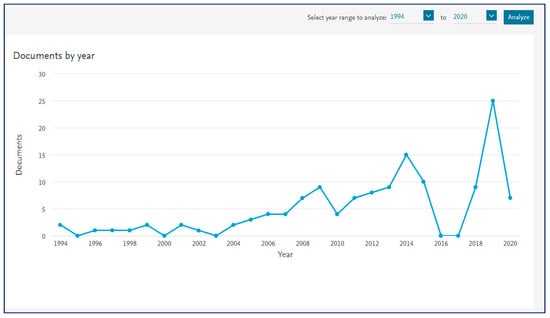
Figure 1.
Results from the search on the Scopus database, 21 March 2020. Employing the keywords “inclusive education”, “sustainability”, and “disability”.
In addition, an analysis according to document type was carried out. As can be seen in Figure 2, 66.2% of the documents are scientific articles, followed by Conference Papers (15.0%).
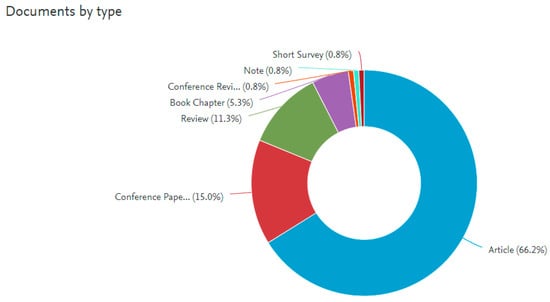
Figure 2.
The distribution as a percentage of the document type, taken from the Scopus database, 21 March 2020.
In a similar manner, we analyzed the countries in which these types of studies were being carried out. In Figure 3, it is possible to verify that the countries most involved are The United States, Australia, The United Kingdom, Canada, India, Germany, Spain, Brazil, China, and Hong Kong.
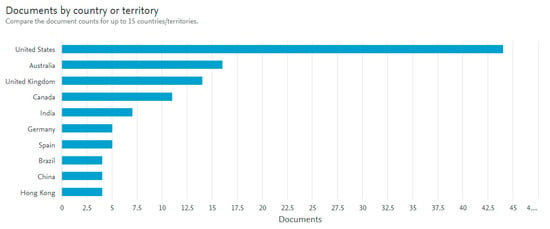
Figure 3.
The distribution of the documents by region, taken from Scopus database, 21 March 2020.
On the other hand, it is important to point out that the universities involved in these studies can be fundamentally classified into two categories: Technological and medical (see Figure 4).

Figure 4.
The distribution of the documents by affiliation to research center, taken from the Scopus database, 21 March 2020.
2.3. Instruments
Scientific databases: Web of Science and Scopus.
2.4. Procedure
Firstly, a search of the bibliography on the Scientific databases Web of Science and Scopus was carried out. The search criteria used was “inclusive education”, “sustainability”, and “disability”. As can been verified in Figure 1, dating before 2019, there were very few studies recorded. That is the reason that it was decided to limit the search of articles published to the period between the years 2018 and 2020, as in this period of time, there was a concentration of the highest percentage of publications that included the keywords being studied. According to this criteria, 54 references were obtained.
Two types of studies were subsequently carried out. Firstly, a quantitative analysis was carried out classifying the articles according to the following criteria: The group being referred to, the year of publication, and the aim of the study. The results are shown in Section 3. Subsequently, data and text mining techniques were applied in order to analyze the results obtained from the classification mentioned above. Secondly, a qualitative study was carried out of the articles in order to look at the concepts used in the 54 articles, classifying them according to categories and highlighting the key concepts In order to do so, the Atlas. ti. v8 [62] tool was used, and an analysis of networks was carried out.
2.5. Data Analysis
Regarding the first design, and to counteract the questions being studied, the following were applied: Descriptive statistics techniques (analysis of frequencies, mathematical average, and standard deviation) and data mining techniques those of unsupervised learning, specifically K-means clustering). Similarly, in order to view the results, Orange v.3.24 [63] Software was used. With regards to the second design, qualitative data analysis techniques of the record of frequencies and an analysis of networks were used, for which the handling, processing, and data viewing software Atlas. ti. v8 [62] was used.
3. Results
3.1. Quantitative Analysis of the Articles
3.1.1. Classification of the Articles
The first aim was regarding the analysis of the research on sustainability, inclusive education, and disability. Firstly, it was verified that the studies that included these three traceability references were very few, n = 54. Subsequently, these studies were ordered by year of publication and were also categorized according to the group that they referred to (1 = Disability, 2 = Society, 3 = Higher Education, 4 = Childhood Education, 5 = High School and Higher Education, 6 = Primary School, 7 = All, 8 = High School). On the other hand, the articles were classified according to their content, for which six reference criteria were established (C1 = Sustainability, C2 = Inclusive Society, C3 = Technology, C4 = Innovative Education, C5 = Active Methodologies, and C6 = Society and Economy). The categorization of the studies and of the frequencies found can be seen in Table 1.

Table 1.
Classification of documents.
As can be seen in Figure 5, the distribution of percentages according to categories is as follows: 100% in the Category C1 = Sustainability, 9.3 % in the Category C2 = Inclusive Society, 9.3% in the Category C3 = Technology, 63% in the Category C4 = Educational Innovation, 50% in the Category C5 = Active Methodologies, and 37% in the Category C6 = Society and Economy (it must be taken into account that the categorization may occur in more than one category).
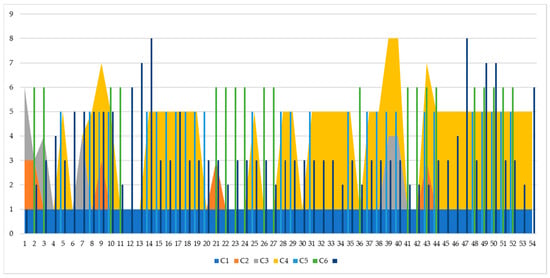
Figure 5.
The analysis of the frequencies of the distribution of the classification of documents. Note. C1 = Sustainability, C2 = Inclusive Society, C3 = Technology, C4 = Educational Innovation, C5 = Active Methodologies, and C6 = Society and Economy.
3.1.2. The Application of Data Mining Techniques
Firstly, K-Means Clustering Technique was applied through the Software SPSS v.24 [64] on the data matrix of the frequencies (Table 1). Three clusters were found, whose distribution according to categorization can be seen in Table 2. Furthermore, the number of the cluster that corresponds with one of the articles studied was maintained (this can see in Table 1).

Table 2.
Centers of final clusters.
Subsequently, with the Software Orange, [63] the results were viewed from the application of the K-means Clustering Technique. In Figure 6, the distribution of the clusters into the categorization can be seen. As can be verified, Cluster 1 includes categories C2 (Inclusive Society), C4 (Educational Innovation), and C5 (Active Methodologies). With respect to Cluster 2, categories C5 (Active Methodologies) and C6 (Society and Economy) were found. With respect to Cluster 3, it included C2 (Inclusive Society) and C6 (Society and Economy).
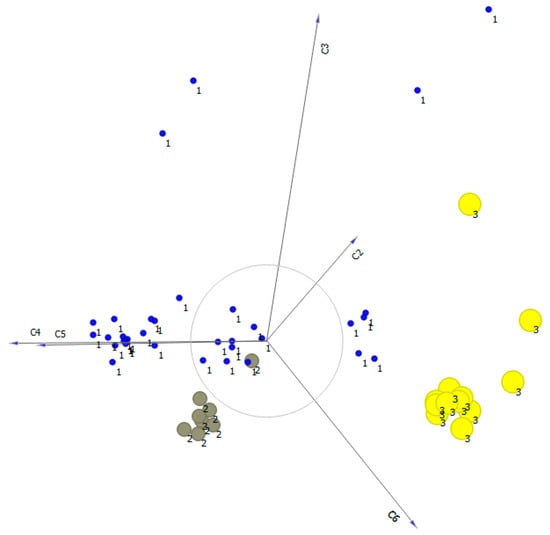
Figure 6.
The distribution of clusters into categories established in the articles.
Subsequently, a study on the distribution of the clusters according to the aim of the article and the year of publication was carried out. As can be verified in Figure 7, Clusters 1 and 2 are more related to the aim of the article and year of publication. This result is shown in the heat map that is shown in Figure 8, where the indicators of the greatest differentiation are the aim of the article and the year of publication.
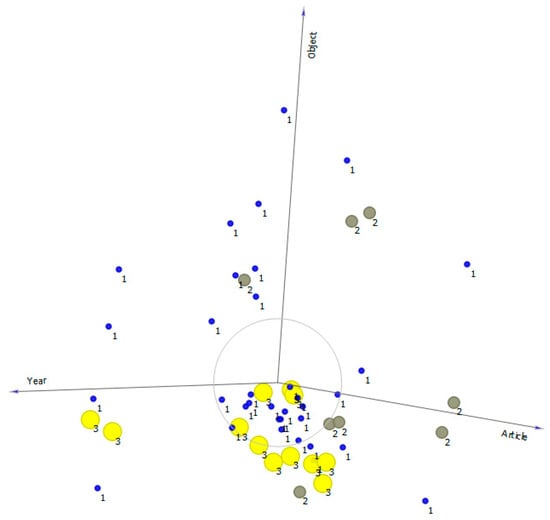
Figure 7.
The distribution of clusters into categories established in the articles as regards the article, the aim of the study, and the year of publication.
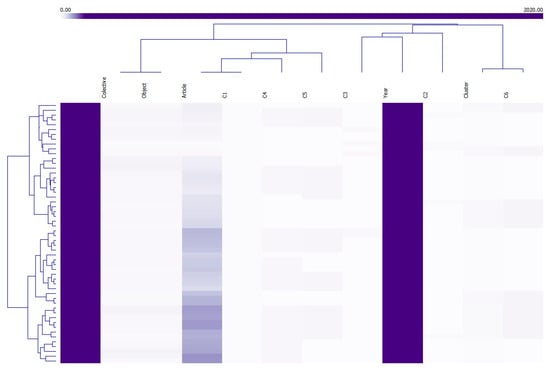
Figure 8.
Heat map related to the variables studied.
3.1.3. The Application of Text Mining Techniques
An analysis of the information in the articles was also carried out applying the technique of text mining, the analysis of words with the software Atlas.ti v.8 [51]. A total of 24,916 words were recorded. Subsequently, the list of words was cleaned, eliminating characters, linking words, and non-representative signs, and 4780 words were accounted for. Furthermore, a hierarchical analysis was carried out using the following distribution: Sustainability n = 4780, Education n = 3700, Learning n = 2504, Students n = 2071, and Research = 1708.
3.2. Qualitative Analysis
The articles were uploaded onto the software Atlas.ti v.8 [50], where 48 out of the 54 articles selected could be included. Due to formatting reasons, six of the articles were unable to be included. Subsequently, the categorization of each of the articles was carried out using the categories of Learning methodology, Educational policy, and Sustainability society as reference. Moreover, each of these included more specific subcategories (see Table 3).

Table 3.
Classification of categories and classification of key concepts.
Subsequently, an analysis of networks within learning methodology was carried out (see Figure 9), Educational policy (see Figure 10) and Sustainability society (see Figure 11), where the linkages of “is a property of”; “is a part of”; “is associated with”, and “is associated with” were applied.
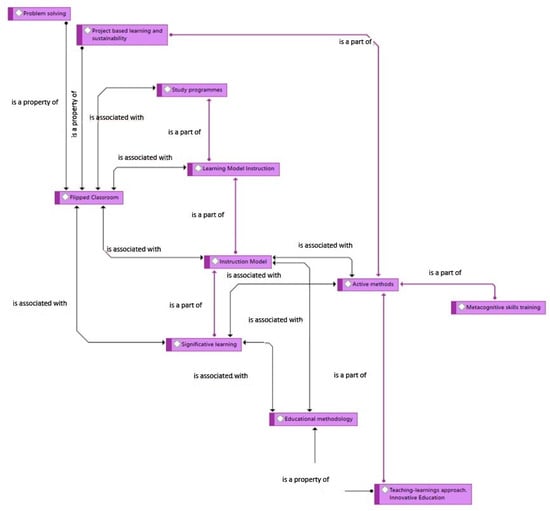
Figure 9.
Analysis of networks con Atlas.ti. v.8 in the classification learning methodology.
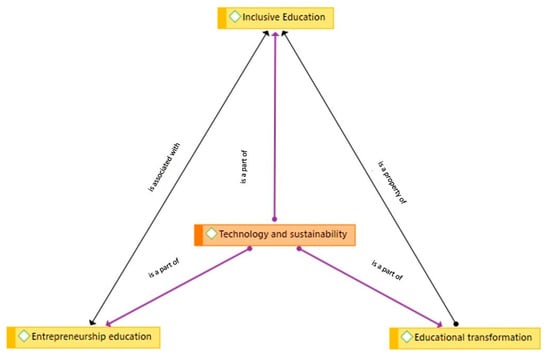
Figure 10.
Analysis of networks with Atlas.ti. v.8 in the classification Educational policy.
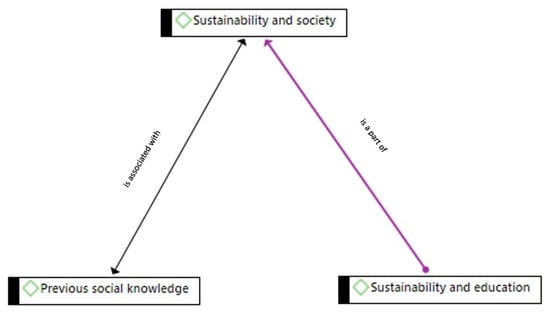
Figure 11.
Analysis of networks with Atlas.ti. v.8 in the classification Sustainability and Society.
After this, an analysis of co-occurrences between the categories included in the classification of Learning Methodology, Educational Policy, and Sustainability Society. As can been seen in Table 4, the highest relations according to Krippendorff’s Alpha Coefficient are: The relation between Educational transformation and the use of Active methods (K = 0.22), Educational Transformation and Educational Methodology (K = 0.22), Educational Transformation and Technology and Sustainability and Active Methods (K = 0.11), and Educational Transformation and Technology and Sustainability and Teaching-Learnings Approach Innovative Education (K = 0.13).

Table 4.
The distribution of frequencies and Krippendorff’s alpha coefficient in the co-occurrences in the classification Learning methodology and Educational policy.
After this, an analysis of co-occurrences between the categories included in the classification of Learning Methodology and those included in the classification of Sustainability Society was conducted. As can be seen in Table 5, the greatest relation according to Krippendorff’s Alpha Coefficient are between Sustainability and Education and Teaching-Learning Approach Innovative Education (K = 0.19).

Table 5.
The distribution of frequencies and Krippendorff’s alpha coefficient in the co-occurrences in the Learning methodology and Sustainability Society classification.
Finally, the table of the co-occurrences between the categories included in the classification of Learning Methodology, and those included in the classification Educational Policy and Sustainability Society, is presented. As can be seen in Table 6, the greatest relation according to Krippendorff’s Alpha Coefficient are between Sustainability and Education and Technology and Sustainability (K = 0.11) and between Sustainability and Society and Inclusive Education (K = 0.12).

Table 6.
The distribution of frequencies and Krippendorff’s Alpha coefficient in the co-occurrences table in the classification of Educational policy and Sustainability Society.
4. Discussion
On the one hand, the objectives were to establish the results of the research related to the concepts of sustainability, inclusive education, and disability. The systematic scientific literature review revealed that the concepts of sustainability are looked at from different perspectives. Initially, the research studies focused more on the social and economic aspects and on the connection with the environment [5,29]. However, in the past few years, these studies are looking at how to achieve a more inclusive society [33,45] and the necessary changes in the educational system to achieve this. There also exists another area of research, which focuses on studying how to achieve a more inclusive society by means of innovative education, where different types of active methodologies are used. Finally, another set of studies are focused on the influence of the inclusive society and on the necessary setting for social and economic change. What is clear is that sustainability is related to education, learning, students, and research. These are the key techniques that the studies currently address. In the same way, it has been verified that studies on sustainability opt to use active methodologies in the context of teamwork [15]. Furthermore, within these methodologies, project-based learning [15], the use of technological resources in flipped learning experiments [20], monitoring experiments [21], and those of gaming [23] stand out. The research references the need to place special attention on teacher training [24,31,32], on the development on Curricula that spans across the different stages of education [25], and in life-long learning [21,37,38]. Likewise, it makes a case for interdisciplinarity [34,43] going beyond the traditional cases of Engineering and Environmental qualifications [26]. Moreover, educational policy is another relevant conceptual element that pursues social transformation [33], inclusive education [26], business education [8], and the development of educational programs that include the concept of sustainability throughout the entire education system, [19,24,25] and that also includes technological advances. Finally, at a greater degree of abstraction, the inclusion of all of the above will manage to achieve the greatly desired more sustainable society. Another relevant aspect is research methodology; several of the studies analyzed include mixed method techniques [46,47] as a facilitator of the bibliometric analysis carried out, both the quantitative and the qualitative, since it enables a triangulated vision [47] of the content of the articles [43], which permits the specification of the explanatory models of intervention [44]. In a similar manner, the use of data and text mining techniques has facilitated the analysis of the information gathered in the articles and has simplified the process of comprehension and of the interrelation between the different documents [57,58,59,60].
Another important aspect is the lack of studies referring to sustainable education related to catering for people with disabilities, as only one study has been found [26]. This is why it is necessary to increase these types of studies since they are included in inclusive education on several occasions [45]. However, disability has specific connotations that need to be looked at in a desegregated way [8,26].
The second objective of this research was to study the key concepts that are detected in the articles selected with respect to the concepts of sustainability, inclusive education, disability, and their relations. It was discovered that highest relations according to Krippendorff’s Alpha Coefficient were found for the keywords Educational transformation and use of Active methods, Educational Transformation and Educational Methodology, Educational Transformation and Technology and Sustainability with the application of Active Methods, and finally Educational Transformation and Technology and Sustainability and Teaching-Learnings Approach and Innovative Education.
Limitations and Future Lines of Research
At its initial stage, the concept of sustainability focused on revealing human beings’ actions against the environment that were having negative impacts on the planet and on the lives of people. However, in the last few years, research has been targeted towards showing that establishing a sustainable society and social transformation can only be achieved based on educational reform and this can only be achieved by using innovative Teaching-Learning methods based on technological resources. In order meet these challenges, on the part of government leaders, there needs to be an active global involvement centered on legislative reform and the investing of resources. A culture of sustainability needs to be inculcated from childhood and should continue throughout a person’s entire life. This will facilitate the application of the concepts of sustainability in different areas, services, and businesses [9,11,12] and will enable a more sustainable society committed to respecting the environment to be achieved [40,41]. Future research will be targeted towards establishing the impact of the experiments in education orientated towards real, sustainable social inclusion in different groups.
5. Conclusions
Educating people on sustainable attitudes and skills is to invest in a better future for the human race. This study has helped establish the type of studies carried out in the area of sustainability from an inclusive education approach. Specifically, it has been found that there are few studies focused on studying educational approaches to promoting sustainable education among disabled people. For this reason, experiments such as those carried out in the European project SUSKIDS [35] will enable it to be established how sustainability training in these groups promotes the adoption of sustainable conduct both in the users as well as in their families.
Author Contributions
Conceptualization, M.C.S.-M. and S.G.-G.; methodology, M.C.S.-M.; formal analysis, M.C.S.-M.; investigation, M.C.S.-M. and M.Á.Q.-D.; resources, M.C.S.-M.; data curation, M.C.S.-M. and S.G.-G.; writing—original draft preparation, M.C.S.-M. and S.G.-G.; writing—review and editing, M.C.S.-M., S.G.-G., and Á.R.; visualization, Á.R., L.A.C.-R., and V.C.; supervision, M.C.S.-M.; project administration, M.C.S.-M.; funding acquisition, S.G.-G. All authors have read and agreed to the published version of the manuscript.
Funding
This work was funded through the European Project “Enabling professionals and families to transfer SU Stainable knowledge and Skills to down syndrome individuals” 2018-ES01-KA201-050639 COORDINADOR 7.
Conflicts of Interest
The authors declare that the research was conducted in the absence of any commercial or financial relationships that could be construed as a potential conflict of interest.
References
- Reid, A. Climate change education and research: Possibilities and potentials versus problems and perils? Environ. Educ. Res. 2019, 25, 767–790. [Google Scholar] [CrossRef]
- Verd Pericás, J. Introducción a la Investigación Cualitativa; Introduction to Qualitative Research; Synopsis: Madrid, Spain, 2016. [Google Scholar]
- Martínez, R.; Castellano, M.A.; Chacón, J.C. Métodos de Investigación en Psicología; Research Methods in Psychology; EOS: Madrid, Spain, 2014. [Google Scholar]
- Plano Clark, V.L.; Ivankova, N.V. Mixed Methods Research: A Practical Guide to the Field; Thousand Sage: Oaks, CA, USA, 2016. [Google Scholar] [CrossRef]
- Dang, V.T.; Wang, J.; Van-Thac Dang, W. An integrated fuzzy AHP and fuzzy TOPSIS approach to assess sustainable urban development in an emerging economy. Int. J. Environ. Res. Public Health 2019, 16, 2902. [Google Scholar] [CrossRef] [PubMed]
- Peter, M.; Diekötter, T.; Kremer, K. Participant outcomes of biodiversity citizen science projects: A systematic literature review. Sustainability 2019, 11, 2780. [Google Scholar] [CrossRef]
- Lengyel, A.; Kovács, S.; Müller, A.; Dávid, L.; Szőke, S.; Bácsné Bába, É. Sustainability and Subjective Well-Being: How Students Weigh Dimensions. Sustainability 2019, 11, 6627. [Google Scholar] [CrossRef]
- Rivas Hermann, R.; Bonzanini Bossle, M. Bringing an entrepreneurial focus to sustainability education: A teaching framework based on content analysis. J. Clean Prod. 2020, 246, 119038. [Google Scholar] [CrossRef]
- Burns, H.; Schneider, M. Insights from Alumni: A Grounded Theory Study of a Graduate Program in Sustainability Leadership. Sustainability 2019, 11, 5223. [Google Scholar] [CrossRef]
- Bolger, D.T.; Bieluch, K.H.; Krivak-Tetley, F.E.; Maggs-Kölling, G.; Tjitekulu, J. Designing a real-world course for environmental studies students: Entering a social-ecological system. Sustainability 2018, 10, 2546. [Google Scholar] [CrossRef]
- Sundermann, A.; Fischer, D. How Does Sustainability Become Professionally Relevant? Exploring the Role of Sustainability Conceptions in First Year Students. Sustainability 2019, 11, 5155. [Google Scholar] [CrossRef]
- Shawe, R.; Horan, W.; Moles, R.; O’Regan, B. Mapping of sustainability policies and initiatives in higher education institutes. Environ. Sci. Policy 2019, 99, 80–88. [Google Scholar] [CrossRef]
- Gray, S.; Sterling, E.J.; Aminpour, P.; Goralnik, L.; Singer, A.; Wei, C.; Akabas, S.; Jordan, R.C.; Giabbanelli, P.J.; Hodbod, J.; et al. Assessing (social-ecological) Systems Thinking by Evaluating Cognitive Maps. Sustainability 2019, 11, 5753. [Google Scholar] [CrossRef]
- Meisert, A.; Böttcher, F. Towards a Discourse-Based Understanding of Sustainability Education and Decision mMking. Sustainability 2019, 11, 5902. [Google Scholar] [CrossRef]
- Zhou, X.; Chen, L.H.; Chen, C.L. Collaborative Learning by Teaching: A Pedagogy between Learner-Centered and Learner-Driven. Sustainability 2019, 11, 1174. [Google Scholar] [CrossRef]
- Benner, J.; McArthur, J.J. Data-Driven Design as a Vehicle for BIM and Sustainability Education. Buildings 2019, 9, 103. [Google Scholar] [CrossRef]
- Grohs, J.R.; Kinoshita, T.; Novoselich, B.J.; Knight, D.B. Exploring Learner Engagement and Achievement in Large Undergraduate Engineering Mechanics Courses. In Proceedings of the ASEE Annual Conference & Exposition, Seattle, WA, USA, 14–17 June 2015. [Google Scholar] [CrossRef]
- LeVasseur, T.; Ciarcia, C. Sustainability Literacy in a Time of Socio-Ecological Crisis: Using Reaccreditation as a Leverage Point for Innovation in Higher Education. Sustainability 2019, 11, 5104. [Google Scholar] [CrossRef]
- Kopnina, H.; Saari, M.H. If a tree falls: Business students learning active citizenship from environmentalists. Educ. Sci. 2019, 9, 284. [Google Scholar] [CrossRef]
- Tomas, L.; Evans, N.; Doyle, T.; Skamp, K. Are first year students ready for a flipped classroom? A case for a flipped learning continuum. Int. J. Educ. Technol. High. Educ. 2019, 16, 5. [Google Scholar] [CrossRef]
- Greig, A.; Priddle, J. Mapping Students’ Development in Response to Sustainability Education: A Conceptual Model. Sustainability 2019, 11, 4324. [Google Scholar] [CrossRef]
- Marzetta, K.; Mason, H.; Wee, B. ‘Sometimes they are fun and sometimes they are not’: Concept mapping with English language acquisition (ELA) and gifted/talented (GT) elementary students learning science and sustainability. Educ. Sci. 2018, 8, 13. [Google Scholar] [CrossRef]
- Fjællingsdal, K.S.; Klöckner, C.A. Gaming Green: The Educational Potential of Eco—A Digital Simulated Ecosystem. Front. Psychol. 2019, 10, 2846. [Google Scholar] [CrossRef]
- Whalen, K.; Paez, A. Development of a new framework to guide, assess, and evaluate student reflections in a university sustainability course. Teach. Learn. Inq. 2019, 7, 55–77. [Google Scholar] [CrossRef]
- Muldrow, L.; Chambers, B.; Newell, M.; Salter, A. Sustainability infused across the curriculum at a minority-serving liberal arts institution: A case study. Int. J. High. Educ. 2019, 8, 1–9. [Google Scholar] [CrossRef]
- Raley, S.K.; Burke, K.M.; Hagiwara, M.; Shogren, K.A.; Wehmeyer, M.L.; Kurth, J.A. The Self-Determined Learning Model of Instruction and Students with Extensive Support Needs in Inclusive Settings. Intellect. Dev. Disabil. 2020, 58, 82–90. [Google Scholar] [CrossRef] [PubMed]
- Palmberg, I.; Kärkkäinen, S.; Jeronen, E.; Yli-Panula, E.; Persson, C. Nordic student teachers’ views on the most efficient teaching and learning methods for species and species identification. Sustainability 2019, 11, 5231. [Google Scholar] [CrossRef]
- Krogman, N.T.; Bergstrom, A. Sustainable Higher Education Teaching Approaches. In Handbook of Engaged Sustainability; Dhiman, S., Marques, J., Eds.; Springer: Cham, Switzerland, 2018; pp. 445–469. [Google Scholar] [CrossRef]
- Zamora-Polo, F.; Sánchez-Martín, J. Teaching for a better world. Sustainability and Sustainable Development Goals in the Construction of a Change-Maker University. Sustainability 2019, 11, 4224. [Google Scholar] [CrossRef]
- Mukhtar, N.; Saud, M.S.B. Sustainability thinking in the paradigm of electrical/electronic engineering: Concept and relevance. Int. J. Eng. Adv. Technol. 2019, 8, 1029–1038. [Google Scholar] [CrossRef]
- Condeza-Marmentini, A.; Flores-González, L. Teachers’ Transgressive Pedagogical Practices in Context: Ecology, Politics, and Social Change. Sustainability 2019, 11, 6145. [Google Scholar] [CrossRef]
- Reeves, A. Classroom collaborations: Enabling sustainability education via student-community co-learning. Int. J. Sustain. High. Educ. 2019, 20, 1376–1392. [Google Scholar] [CrossRef]
- Wamsler, C. Education for sustainability: Fostering a more conscious society and transformation towards sustainability. Int. J. Sustain. High. Educ. 2020, 21, 112–130. [Google Scholar] [CrossRef]
- Westermark, Å.; Jansund, B. Learning experiences from a time-geographic approach—Commodity chains, globalization, everyday life, and sustainability in context. J. Geogr. High. Educ. 2019, 43, 486–504. [Google Scholar] [CrossRef]
- Project “SUSKIDS Enabling Professionals and Families to Transfer Sustainable Knowledge and Skills to down Syndrome Individuals”. ERASMUS+KA2. Strategic Associations School Education. 2018-1-ES01-KA201-050639. Available online: http://suskids.eu/ (accessed on 21 August 2020).
- Papenfuss, J.; Merritt, E. Pedagogical laboratories: A case study of transformative sustainability education in an ecovillage context. Sustainability 2019, 11, 3880. [Google Scholar] [CrossRef]
- Evans, T.L. Competencies and pedagogies for sustainability education: A roadmap for sustainability studies program development in colleges and universities. Sustainability 2019, 11, 5526. [Google Scholar] [CrossRef]
- Boldermo, S.; Ødegaard, E.E. What about the Migrant Children? The State-of-the-Art in Research Claiming Social Sustainability. Sustainability 2019, 11, 459. [Google Scholar] [CrossRef]
- Činčera, J.; Mikusinśki, G.; Binka, B.; Calafate, L.; Calheiros, C.; Cardoso, A.; Hedblom, M.; Jones, M.; Koutsouris, A.; Vasconcelos, C.; et al. Managing Diversity: The Challenges of Inter-University Cooperation in Sustainability Education. Sustainability 2019, 11, 5610. [Google Scholar] [CrossRef]
- Jarillo, M.P.; Pedraza, L.; Ger, P.M.; Bocos, E. Challenges of Online Higher Education in the Face of the Sustainability Objectives of the United Nations: Carbon Footprint, Accessibility and Social Inclusion. Sustainability 2019, 11, 5580. [Google Scholar] [CrossRef]
- Van Poeck, K. Environmental and sustainability education in a post-truth era. An exploration of epistemology and didactics beyond the objectivism-relativism dualism. Environ. Educ. Res. 2019, 25, 472–491. [Google Scholar] [CrossRef]
- Holfelder, A. Towards a sustainable future with education? Sustain. Sci. 2019, 14, 943–952. [Google Scholar] [CrossRef]
- Pompeii, B.; Chiu, Y.W.; Neill, D.; Braun, D.; Fiegel, G.; Oulton, R.; Ragsdale, J.; Singh, K. Identifying and Overcoming Barriers to Integrating Sustainability across the Curriculum at a Teaching-Oriented University. Sustainability 2019, 11, 2652. [Google Scholar] [CrossRef]
- Akins, E.E.; Giddens, E.; Glassmeyer, D.; Gruss, A.; Hedden, M.K.; Slinger-Friedman, V.; Weand, M. Sustainability Education and Organizational Change: A critical Case Study of Barriers and Change Drivers at a Higher Education Institution. Sustainability 2019, 11, 501. [Google Scholar] [CrossRef]
- Fang, X.; Zhou, B.; Tu, X.; Ma, Q.; Wu, J. “What Kind of a Science is Sustainability Science?” An Evidence-Based Reexamination. Sustainability 2018, 10, 1478. [Google Scholar] [CrossRef]
- Anguera, M.T.; Blanco-Villaseñor, A.; Losada, J.L.; Portell, M. Guidelines for designing and conducting a study that applies observational methodology. Anu. Psicol. 2018, 48, 9–17. [Google Scholar] [CrossRef]
- Krippendorff, K. Content Analysis: An Introduction to Its Methodology, 3rd ed.; Sage Thousand: Oaks, CA, USA, 2013. [Google Scholar]
- Sáiz-Manzanares, M.C.; Queiruga Dios, M.Á.; García-Osorio, C.I.; Montero-García, E.; Rodríguez-Medina, J. Observation of Metacognitive Skills in Natural Environments: A Longitudinal Study with Mixed Methods. Front. Psychol. 2019, 1, 2398. [Google Scholar] [CrossRef]
- Sáiz, M.C.; Escolar, M.C. Observación Sistemática e Investigación en Contextos Educativos; Systematic Observation and Research in Educational Contexts; University of Burgos Publication Service: Burgos, Spain, 2013. [Google Scholar]
- Banks, M. Los Datos Visuales en Investigación Cualitativa; Using Visual Data in Qulitative Research; Morata: Madrid, Spain, 2010. [Google Scholar]
- Gibbs, G. El Análisis de Datos Cualitativos en Investigación Cualitativa; Analyzing Qualitative Data; Morata: Madrid, Spain, 2013. [Google Scholar]
- Anguera, M.T. Developing indirect observation: Scope, process and methodological skills in the analysis of texts. In Análisis de Patrones de Habilidades Metodológicas y Conceptuales de Análisis, Planeación, Evaluación e Intervención; Analysis of Patterns of Methodological and Conceptual Skills of Analysis, Planning, Evaluation and Intervention; Santoyo, C., Ed.; UNAM/PAPIIT: Ciudad de México, Mexico, 2020; in press. [Google Scholar]
- Sáiz-Manzanares, M.C.; Queiruga-Dios, M.Q. Evaluación de estrategias metacognitivas: Aplicación de métodos online. Rev. Psicol. Educ. 2018, 13, 33–45. [Google Scholar] [CrossRef]
- Manzanares, M.C.S.; Sánchez, R.M.; González, Á.A.; Llamazares, M.D.C.E.; Dios, M.Á.Q. Detección del alumno en riesgo en titulaciones de Ciencias de la Salud: Aplicación de técnicas de Learning Analytics. Eur. J. Investig. Health Psychol. Educ. 2018, 8, 129–142. [Google Scholar] [CrossRef]
- Sáiz-Manzanares, M.C.; Escolar-Llamazares, M.C.; Rodríguez-Medina, J. Investigación Cualitativa. Aplicación de Métodos Mixtos y de Técnicas de Minería de Datos; Qualitative Research. Application of Mixed Methods and Data Mining Techniques; University of Burgos Publication Service: Burgos, Spain, 2019. [Google Scholar]
- Silva, E.T.; Sampaio, F.; da Silv, L.C.; Medeiros, D.S.; Correia, G.P. A method for embedding a computer vision application into a wearable device. Microprocess. Microsyst. 2020, 76, 103086. [Google Scholar] [CrossRef]
- García, S.; Luengo, J.; Herrera, F. Data Preprocessing in Data Mining; Springer International Publishing: Cham, Switzerland, 2015; Volume 72. [Google Scholar]
- Pejic-Bach, M.; Bertoncel, T.; Meško, M.; Krstić, Ž. Text mining of industry 4.0 job advertisements. Int. J. Inf. Manag. 2020, 50, 416–431. [Google Scholar] [CrossRef]
- Slater, S.; Joksimović, S.; Kovanovic, V.; Baker, R.S.; Gasevic, D. Tools for Educational Data Mining: A Review. J. Educ. Behav. Stat. 2016, 42, 85–106. [Google Scholar] [CrossRef]
- Romero, C.; Ventura, S. Educational data mining: A survey from 1995 to 2005. Expert Syst. Appl. 2007, 33, 135–146. [Google Scholar] [CrossRef]
- Sáiz-Manzanares, M.C.; García-Osorio, C.I.; Díez-Pastor, J.F. Differential efficiency of the resources used in b-learning environments. Psicothema 2019, 31, 170–178. [Google Scholar] [CrossRef]
- Atlas.ti. Software Package Qualitative Data Analysis; Version 8; Atlas.ti Scientific Software Development GmbH: Berlin, Germany, 2020; Available online: https://atlasti.com/es/ (accessed on 20 August 2020).
- Orange. Software Package. Available online: https://orange.biolab.si/docs/ (accessed on 20 August 2020).
- IBM Corp. SPSS Statistical Package for the Social Sciences (SPSS); Version 24; IBM: Madrid, Spain, 2016. [Google Scholar]
© 2020 by the authors. Licensee MDPI, Basel, Switzerland. This article is an open access article distributed under the terms and conditions of the Creative Commons Attribution (CC BY) license (http://creativecommons.org/licenses/by/4.0/).